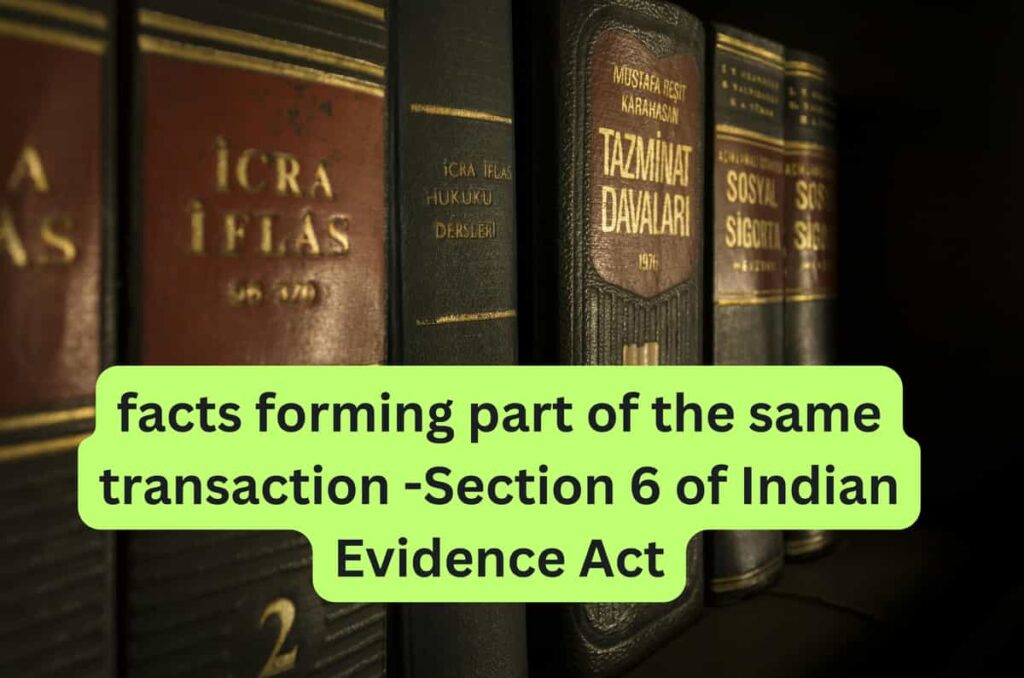Section 6 of Indian Evidence Act, 1872 deals with the relevancy of facts forming part of the same transaction. It states that:
Facts which, though not in issue, are so connected with a fact in issue as to form part of the same transaction, are relevant, whether they occurred at the same time and place or at different times and places.
This means that even if a fact is not directly relevant to the case, it may still be admissible in evidence if it is connected with a fact in issue and forms part of the same transaction.
The purpose of Section 6 of Indian Evidence Act is to allow the Court to hear a complete picture of the events that led up to and occurred during the main event that is at issue in the case. This helps the Court to understand the context of the case and to assess the evidence fairly.
Examples of facts forming part of the same transaction -Section 6 of Indian Evidence Act
-
Section 6 of the Indian Evidence Act deals with the relevancy of facts forming part of the same transaction. This essentially means that even though a fact might not be directly related to the main issue of the case (e.g., whether a murder happened or not), it can still be presented as evidence if it’s connected to the main event. Here’s a breakdown of your examples with explanations:
Murder Case:
- Relationship between murderer and victim: This helps establish motive, opportunity, or premeditation. For example, a strained relationship with a history of arguments suggests a higher likelihood of a crime of passion.
- Events leading up to the murder (arguments, threats): These directly connect to the act itself and can show intent or premeditation. If the accused threatened violence beforehand, it strengthens the prosecution’s case.
- Events during the murder (witnesses, statements): Witness accounts and statements made by the murderer or victim during the struggle provide direct evidence of what happened.
- Events after the murder (flight, last words): The murderer’s flight from the scene suggests guilt, while the victim’s last words might identify the attacker.
Theft Case:
- Accused’s presence at the scene: This establishes opportunity. If the accused was seen around the crime scene close to the time of the theft, it’s relevant evidence.
- Accused’s motive: This helps the court understand why the accused might have committed the crime. Financial problems, gambling debts, or a history of theft can all be considered.
- Means and method: This establishes how the theft occurred. Forced entry, picking locks, or using insider knowledge are all relevant facts.
- Discovery of stolen goods: Finding the stolen items with the accused strengthens the prosecution’s case. However, the accused’s explanation needs to be considered as well.
- Accused’s explanation: If the accused has a reasonable explanation for possessing the stolen goods (e.g., they were bought unknowingly), it might weaken the prosecution’s case.
Key Points to Remember:
- The judge ultimately decides whether a fact is part of the same transaction and therefore relevant.
- The closer the connection between the fact and the main event, the more likely it is to be considered relevant.
- The time frame can be flexible. Events shortly before, during, or after the main event can be relevant depending on the circumstances.
By considering these facts forming part of the same transaction, the court can build a more complete picture of the events and make a more informed decision about the case.
Significance of section 6 of Indian Evidence Act: Facts Forming Part Of The Same Transaction
Section 6 of Indian Evidence Act is an important section of the Evidence Act because it allows the Court to hear a complete picture of the events that are relevant to the case. This helps the Court to understand the context of the case and to assess the evidence fairly.
Notes for Judicial Exam : Facts Forming Part Of The Same Transaction
- It is important to be familiar with the concept of facts forming part of the same transaction.
- Facts forming part of the same transaction are relevant even if they are not directly in issue in the case.
- The Court has the discretion to decide whether a fact is part of the same transaction as the main event that is at issue in the case.
- When deciding whether a fact is part of the same transaction, the Court should consider the following factors:
- Is the fact connected with the main event in issue?
- Is the fact likely to help the Court to understand the context of the case or to assess the evidence fairly?
Following are some case laws on section 6 of Indian Evidence Act, 1872, which deals with the relevancy of facts forming part of the same transaction:
Case 1: State of U.P. v. M.P. Sharma (1957) SCR 518
In this case, the Supreme Court held that the confession made by a person in the custody of a police officer is relevant in a criminal case, even if the confession is not admissible in evidence because it was made under duress or inducement. The Court held that the confession is still relevant because it can help the Court to understand the circumstances of the case and to assess the credibility of the accused’s defense.
The Court also held that the fact that the accused was found in possession of the murder weapon shortly after the murder is relevant as forming part of the same transaction. This is because the possession of the murder weapon is a strong indication that the accused was involved in the crime.
Case 2: State of West Bengal v. Anukul Chandra Pramanik (1993) 2 SCC 403
In this case, the Supreme Court held that the fact that the accused is a person of good character is relevant in a criminal case, even if the accused has pleaded not guilty. The Court held that the accused’s character is relevant because it can help the Court to assess the likelihood that the accused committed the crime.
The Court also held that the fact that the accused was seen arguing with the victim shortly before the murder is relevant as forming part of the same transaction. This is because the argument is a strong indication that the accused had a motive for committing the crime.
Case 3: Ram Kishan v. State of Haryana (2009) 13 SCC 296
In this case, the Supreme Court held that the fact that the accused is related to the victim is relevant in a criminal case, even if the accused is not charged with any conspiracy or abetment. The Court held that the accused’s relationship to the victim is relevant because it can help the Court to understand the motive for the crime and to assess the credibility of the accused’s defense.
The Court also held that the fact that the accused was seen fleeing from the scene of the murder is relevant as forming part of the same transaction. This is because the flight is a strong indication that the accused was involved in the crime.
These are just a few examples of case laws on section 6 of the Evidence Act. There are many other case laws that deal with various aspects of the relevancy of facts forming part of the same transaction. It is important for lawyers and judges to be familiar with these case laws so that they can apply them correctly in their cases.
Related Queries
- section 6 of evidence act notes
- section 6 of evidence act example
- section 6 evidence act in hindi
- section 6 of indian evidence act case laws
- section 7 of evidence act
- section 8 of indian evidence act
- a fact forming part of the same transaction, is relevant under section 6 of evidence act
- section 11 of indian evidence act

